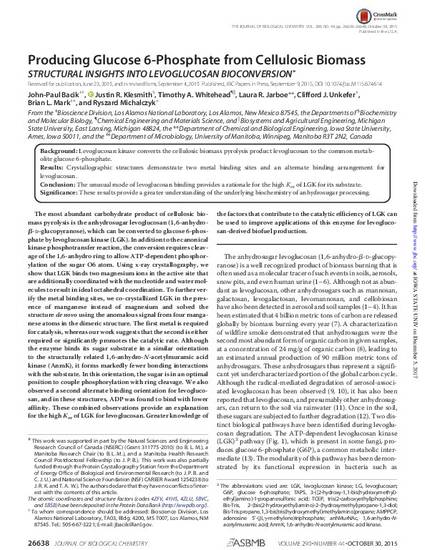
The most abundant carbohydrate product of cellulosic biomass pyrolysis is the anhydrosugar levoglucosan (1,6-anhydro-β-D-glucopyranose), which can be converted to glucose 6-phosphate by levoglucosan kinase (LGK). In addition to the canonical kinase phosphotransfer reaction, the conversion requires cleavage of the 1,6-anhydro ring to allow ATP-dependent phosphorylation of the sugar O6 atom. Using x-ray crystallography, we show that LGK binds two magnesium ions in the active site that are additionally coordinated with the nucleotide and water molecules to result in ideal octahedral coordination. To further verify the metal binding sites, we co-crystallized LGK in the presence of manganese instead of magnesium and solved the structure de novo using the anomalous signal from four manganese atoms in the dimeric structure. The first metal is required for catalysis, whereas our work suggests that the second is either required or significantly promotes the catalytic rate. Although the enzyme binds its sugar substrate in a similar orientation to the structurally related 1,6-anhydro-N-acetylmuramic acid kinase (AnmK), it forms markedly fewer bonding interactions with the substrate. In this orientation, the sugar is in an optimal position to couple phosphorylation with ring cleavage. We also observed a second alternate binding orientation for levoglucosan, and in these structures, ADP was found to bind with lower affinity. These combined observations provide an explanation for the high Km of LGK for levoglucosan. Greater knowledge of the factors that contribute to the catalytic efficiency of LGK can be used to improve applications of this enzyme for levoglucosan-derived biofuel production.
Available at: http://works.bepress.com/laura_jarboe/29/

This research was originally published in J.P. Bacik, J.R. Klesmith, T.A. Whitehead, L.R. Jarboe, C.J. Unkefer, B.L. Mark, R. Michalczyk “Producing glucose-6-phosphate from cellulosic biomass: structural insights into levoglucosan bioconversion” Journal of Biological Chemistry 290:26638-26648 (2015). DOI: 10.1074/jbc.M115.674614. Posted with permission.